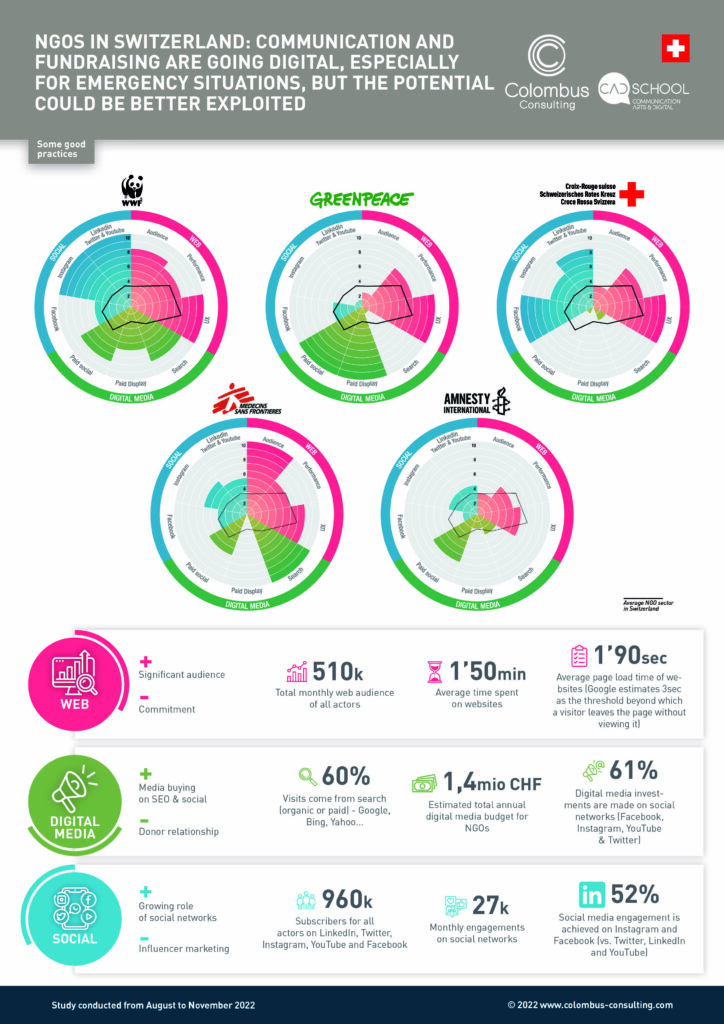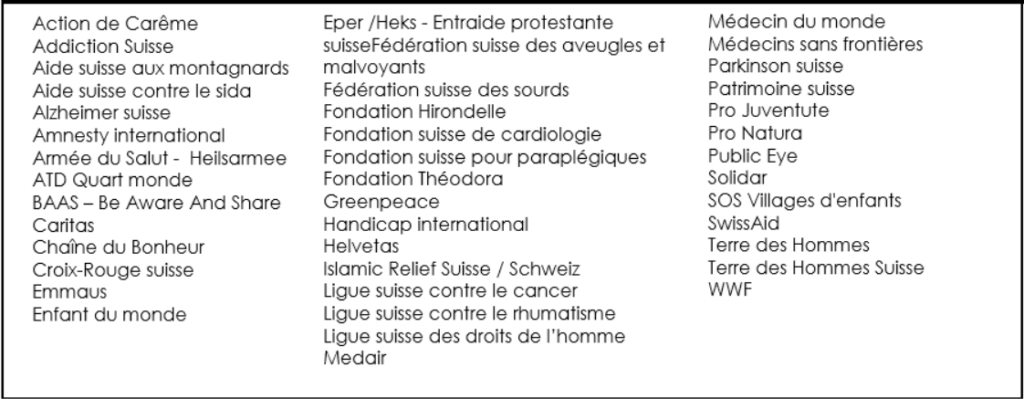NGOs in Switzerland: communication and fundraising are going digital, especially for emergency situations, but the potential could be better exploited.
Our study highlights the digital shift undertaken by NGOs and highlights possible areas of improvement to increase their visibility and increase the fundraising, necessary to carry out their actions.
The main stake of fundraising goes digital
At the heart of the NGOs’ mission is the financing of its activity. Therefore fundraising is key. Historically, donors have been solicited through various operations, notably through direct marketing and household mailings. But the era is also becoming more digital for NGOs in Switzerland.
To develop online donations, NGOs offer new payment methods such as Twint, available for 85% of the panel, and Paypal, available for 49% of the panel. “Only 5% of the NGOs on the panel offer payment in crypto-currency, although this would undoubtedly help to rejuvenate donors,” explains Pierre Berendes, instructor at CAD school and consultant at Colombus Consulting.
NGOs also use paid levers (search, display, social networks), but investments are still timid, totaling 1.4 million CHF per year for all the players on the panel. Even if the organisations benefit greatly from the Google Ad Grants programme, which allows certain ads to be displayed free of charge in paid referencing, the share of paid channels remains low (7%), compared to other sectors for an equivalent audience.
Increased communication on the web
Some NGOs such as the Swiss Paraplegic Foundation or Terre des Hommes allow you to choose to donate specifically for an operation. This is in keeping with the times, but it is also very difficult to manage financially. In terms of donor relations, this requires personalized communication based
on CRM tools.
Diversifying e-commerce services
Donors are informed on an ongoing basis, historically through annual activity reports. The new norm is to develop regular and thematic communications on digital channels, allowing to show donors results in line with operations in the field. For example, MSF publishes infographics mixing figures and images to create emotion and generate the most engagement on digital channels and social networks.
Diversifying eCommerce services
E-commerce is growing, with 50% of NGOs in Switzerland offering this service for gifts, books, promotional items, gift ideas for their supporters, etc. Max Havvelar, for example, shares links for more than 3,000 products to distributors’ websites, and the Salvation Army has a website dedicated to
second-hand items. We point ou that such website « Brocki », is the oldest second hand shop in Switzerland (19th century)… but the relationship with donors could be more digital and more personalised.
Although the relationship with donors has progressed, it remains timid on the digital front. However, emailing donors remains a simple way of keeping in touch with the community in a personalised and targeted way via relational programmes. But these seem to be under-exploited (1% share of traffic for email), whereas they could significantly strengthen the bond, increase the contacts, and therefore boost donation opportunities. This is undoubtedly an area for improvement for NGOs.
Digital, the best ally for emergency situations
Emergency situations by their very nature require a certain speed to mobilise resources, particularly financial ones. From this point of view, digital technology has become the best ally of NGOs for rapid and targeted donations. Recent examples include the Ukrainian conflict: one day after Russia’s attack on Ukraine, the Swiss Red Cross launched a massive online fundraising campaign (which was later extended to other channels such as radio, print and telephone). Just three days later, more than 600,000 Swiss
francs had been donated, culminating in a record 11.1 million francs of online revenue by the end of the operation. An operation that won an award from the Swissfundraising jury.
Crowdfunding has become a classic in just a few years
Crowdfunding is now a traditional method of fundraising that has proven its effectiveness. It is actively used by more than 20% of the NGOs in the panel. NGOs are testing the 40 or so existing platforms (Kickstarter, Funders, Crowdify, etc.) to attract different donors and to determine which ones are the most effective, even though fees can exceed 10% for some players.
The growing role of social networks
NGOs have embraced the codes of social networks rapidly, accumulating nearly one million subscribers in Switzerland on all platforms (Instagram, Facebook, LinkedIn, Twitter, Youtube). However, they are behind on TikTok, with only 5 actors out of 42 having a really active account dedicated to Switzerland: WWF, Pro Juventute, Theodora Foundation, Terre des Hommes and the Salvation Army. These last ones cumulate a little more than 40,000 subscribers, a sign of unfulfilled potential. With over a million users in Switzerland, TikTok is an ideal tool to reach young people. The international accounts of actors such as WWF or Pro Juventude are good examples to follow on this network, with some very popular videos of more than 1 million views.
From ambassadors to influencers, the path is not clear yet
While NGOs have been relying on the reputation of ambassadors for years to promote their cause and activities, they are still very discreet when it comes to collaborating with influencers on social networks. “They are depriving themselves of an organic communication channel and an opportunity to expand their audience,” says Pierre Berendes. There have been a few harmonious collaborations between the Swiss Red Cross and the Swiss athlete Mujinga Kambundji, or between Médecins sans frontières (MSF) and Muse, who gave a concert in Zurich in May 2022 to raise funds.
New links between gaming and NFT
The Gaming community is generous: in 2021, more than 100 million dollars were raised on Twitch with Tiltify. MSF, for example, was able to benefit from 1.8 million dollars at the time of the war in Ukraine. The funds were raised by the Chinese video game studio Riot Games through in-game purchases and special skins on various titles in its catalog.
NFTs are also an interesting tool for fundraising: on the occasion of the 20th anniversary of its Gala, the Swiss Red Cross issued several NFTs that enabled it to raise funds. However, success is not always forthcoming: the WWF had to cancel its NFT sale organised at the beginning of 2022 by its English subsidiary, after having suffered a negative buzz on the use of a crypto-currency that was not very respectful of the environment (Ethereum)… precisely to promote an operation to save animal species. Finally, no initiative has yet been carried out around the metaverse or virtual reality. Is the field considered too risky? NGOs seem to be keeping
a conservative stance on certain innovations.
Digital to make NGOs more efficient in their operations
Fundraising and operating cost ratios are widely scrutinized by donors to ensure that the vast majority of donations are allocated to programmes or operations. Digital also has a key role to play in reducing these costs, both in fundraising activities and in digitization projects which also aim to improve the management of NGO programmes and finances.
“NGOs have understood this interest, and there are many digital transformation projects in the sector, which are also leading to a wider questioning of working methods,” concludes Jean Meneveau, Associate Director at Colombus Consulting.
Digital Index: the sector’s overall digital performance
Colombus Consulting presents below its digital index, which measures the digital performance of NGOs based on 50 indicators divided into three areas: Web, Digital Media and Social.

Methodology
This study was based on measurements carried out in the third quarter of 2022 on a panel of 40 major players in the NGO sector in Switzerland.

The digital index measures the 360° digital presence and performance of players according to more than 50 indicators:
- Website: audience, performance (bounce, visit time and loading), customer experience (design, content and functions)
- Digital media: SEO, display, email, social networks, and partners
- Social networks: Instagram, Linkedin, Facebook, Youtube, Twitter
Solutions used:
We used different market data collection tools, and reworked all the data in the form of an index allowing a simple and visual benchmark of the sector. The chosen solutions are: SimilarWeb, Semrush, BuiltWith and Google.
Fill in this form to download our study